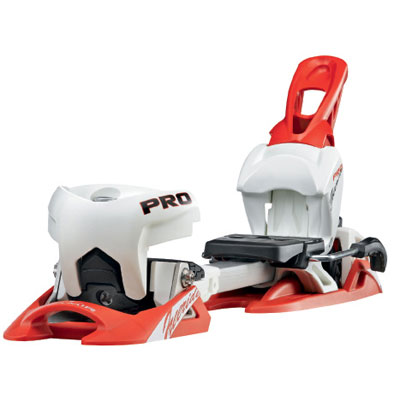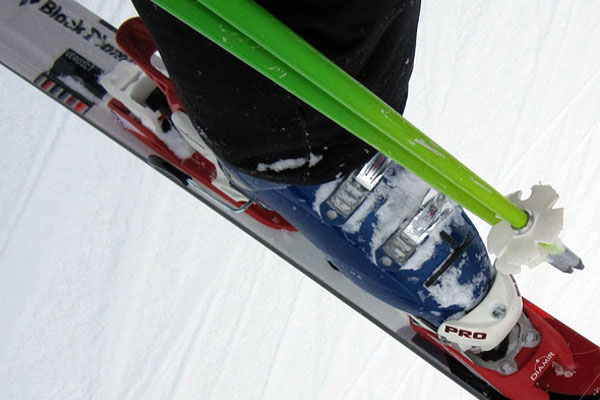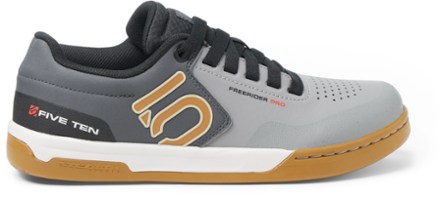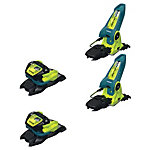Fritschi Freeride Pro

- best all-around A/T binding?
- step-in simplicity
- refined & reliable
- 4lbs 13.5oz/pair (w/brakes)
Fritschi's Freeride Pro binding has gotten so good at so many things it's a safe bet you'll love them no matter what kind of backcountry skier you are.
With years of R&D behind it, and many seasons of consumer testing and feedback, the Freeride Pro is likely the most evolved Alpine Touring Binding you can get today (though perhaps not the most advanced). The latest iteration of the Fritschi series, the Freeride Pro, features modest but focused improvements designed to address downhill performance as well as retention and release safety.

Historically, Fritschi has faced only one significant competitor—Dynafit—which offers a completely different approach to A/T binding engineering.
That has changed. Skiers now have the option of the step-in Marker Tour, which sits almost exactly in the same niche.
We'll return to that subject in a moment. Strengths of the Fritschi include tremendous reliability in the field. When you get a Fritschi binding you are getting an evolved, kink-free design, thanks to Frischi's huge popularity and extensive in-the-field testing over many, many years. Step-in ease and simplicity remain one of the Fritschi's principal advantages over Dynafit, and Frischi enjoys a good (for an A/T binding) safety record when it comes to releasing during a fall.
The Fritchis are potent climbers. With an always-improving toe pivot point, they can't quite match the kick-and-glide of a Dynafit on flat ground, but come into their own when switchbacking up the hill, with reasonable laterally rigidity, an aggressive heel elevator that's easy to adjust on-the-fly, and the excellent optional Axion ski crampons.
The beauty of the Fritschis has always been that it is a kind of mindless binding. There is no learning curve to speak of. Just snap in and go; no worries about ice plugging your tech fitting holes or how to operate quirky heel pieces. There is also no question that the Fritschi Freeride Pro is a touring binding. Whatever your needs, be it a short slackcountry visit or a week-long expedition, the Fritchi is an excellent choice.
Compared especially to earlier Fritschi bindings, the Freeride Pro offers the highest level of downhill performance. Mount width has been increased to better handle the extra size of today's Big Mountain skis. The Freeride Pro's binding plate is sliding to allow your ski to flex naturally—just like a good Alpine ski binding. The toe piece has been strengthened, and Fritschi now claims the binding meets the ISO norm 9462 standard when used with Touring or Alpine ski boots.
On the hill, it seems to me that the Freeride Pro does indeed allow your ski to flex naturally underfoot, translating into a smoother performance (while skiing), especially on hard snow. On the other hand, the fundamental design of the Fritschi toe remains largely the same, which does permit a measure of play in the front of the binding. This is much reduced in the Freeride Pro, to be sure, especially compared to my old Fritschi Explores, but it does remain something of a concern.
It is in this aspect that the Marker Tour enjoys its clearest advantage, in my opinion. The Tour offers a very rigid boot-ski interface, delivering—perhaps—the most Alpine feel of any true touring binding. On the other hand, if touring is your game, you may never notice the downhill differences between the Tour and the Freeride Pro, but you'll certainly notice the Fritchi's much more econometric pivot point, plus the ability to shift between skiing/touring modes on-the-fly. My bottom line is that the waters have grown a little murkier with the addition of the Tour, but the Fritschi remains the A/T step-in binding of choice—for now.






 Look Pivot
Look Pivot Dynafit TLT Vertical
Dynafit TLT Vertical